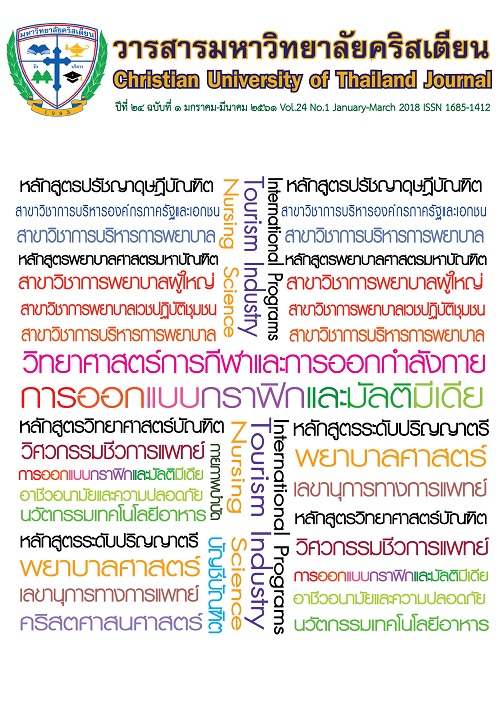มุมมองด้านแรงจูงใจในการเรียนของนักศึกษาพยาบาล
คำสำคัญ:
แรงจูงใจในการเรียน, นักศึกษาพยาบาล, มุมมองด้านแรงจูงใจบทคัดย่อ
แรงจูงใจในการเรียนทั้งแรงจูงใจภายในและภายนอกไม่สามารถแยกจากกัน เป็นปัจจัยกระตุ้นให้เกิดแรงขับจากภายในและเกิดความต้องการที่จะประสบความสำเร็จในการเรียนสำหรับนักศึกษาพยาบาลมีบทบาทสำคัญในการดูแลผู้ป่วยจึงจำเป็นต้องเรียนรู้เกี่ยวกับโรคและการพยาบาลเพื่อเชื่อมโยงสู่การดูแลผู้ป่วยหากนักศึกษาพยาบาลมีแรงจูงใจในการเรียนจะเกิดความขยันและตั้งใจเรียนเพิ่มขึ้นเพื่อให้เกิดผลลัพธ์การเรียนรู้ที่มีประสิทธิภาพ โดยผลการวิเคราะห์ข้อมูลเกี่ยวกับมุมมองด้านแรงจูงใจในการเรียนของนักศึกษาพยาบาลจากกิจกรรมสุนทรียสนทนา พบว่า แรงจูงใจในการเรียนและไม่ตกงาน และ 2) แรงจูงใจในการเรียน ได้แก่ ประกอบด้วย 2 ประเด็น คือ 1) แรงจูงใจที่ทำให้ตัด สินใจเลือกเรียนในสาขาพยาบาลศาสตร์ ได้แก่ การชื่นชอบในวิชาชีพพยาบาล และวิชาชีพพยาบาลมีความมั่นคง ความรักในวิชาชีพการชอบช่วยเหลือผู้อื่นและความมุ่งมั่นในการเรียนเพื่อให้ครอบครัวภูมิใจ ดังนั้น อาจารย์พยาบาลควรมีการจัดกระบวนการเรียนรู้ หรือกิจกรรมที่เสริมสร้างแรงจูงใจในการเรียนให้แก่นักศึกษาพยาบาล เพื่อให้เกิดแรงจูงใจในการเรียน และเกิดผลลัพธ์การเรียนรู้ที่ดีขึ้น
เอกสารอ้างอิง
เจียมใจ ศรีชัยรัตนกูล, ยุพาภรณ์ ติรไพรวงศ์ และเกสร สุวิทยะศิริ. (2016). ความรู้ และพฤติกรรมการดำเนินชีวิตตามหลักปรัชญาเศรษฐกิจพอเพียงของนักศึกษาพยาบาลศาสตร์. วารสารวิทยาลัยพยาบาลบรมราชชนนีกรุงเทพ, 32(3), 74-86.
พิริยลักษณ์ ศิริศุภลักษณ์. (2013). การสอนนักศึกษาพยาบาลเพื่อพัฒนาทักษะการคิดอย่างมีวิจารณญาณ. วารสารวิทยาลัยพยาบาลบรมราชชนนี นครราชสีมา, 19(2), 5-19.
มุสลินท์ โต๊ะกานิและคณะ. (2553). แรงจูงใจภายในด้านการเรียนและบุคลิกภาพพยาบาลวิชาชีพของนักศึกษาพยาบาล ในสามจังหวัดชายแดนภาคใต้. Princess of Naradhiwas University Journal, 2(2), 1-15.
สิทธิพงศ์ วัฒนานนท์สกุล. (2558). จิตวิทยาพื้นฐาน (เอกสารประกอบการสอน). ภาควิชาจิตวิทยา คณะมนุษย์ศาสตร์ มหาวิทยาลัยศรีนครินทรวิโรฒ.
สุรางค์โค้วตระกูล. (2556). จิตวิทยาการศึกษา.พิมพ์ครั้งที่ 11. กรุงเทพมหานคร: โรงพิมพ์แห่งจุฬาลงกรณ์มหาวิทยาลัย.
Aktas, Y.Y., Karabulut, N. (2016). A Survey on Turkish nursing students' perception of clinical learning environment and its association with academic motivation and clinical decision making. Nurse Education Today, 36(1), 124-128.
Cheng, M., Cheng, C., Tian, y., & Fan, x. (2015). Student nurses' motivation to choose gerontological nursing as a career in China: A survey study. Nurse Education Today,35(1) : 843-848.
Coon, D., & Mitterer, J. O. (2013). Introduction to pshchology: gateways to mind and behaviour. 11th ed. Belmont, CA: Wadsworth.
Dolan, K., Perz, A., McComb, S., & Kirkpatrick, J. (2013). Comparing Undergraduate Students' Cognitive Complexity and Motivation to Learn. Industrial and Systems Engineering Research Conference, 1(1), 538-545.
Dupont, S. J. (2012). Nursing faculty motivation to use high-fidelity simulation: An application of Keller's ARCS Model. the Degree Doctor of Philosophy. Capella University.
Erten, H. I. (2014). Interaction between academic motivation and student teachers' academic achievement. Procedia - Social and Behavioral Sciences, 152(1), 173 - 178.
Hanifi, N., Parvizy, S., & Joolaee, S. (2013). Motivational journey of Iranian bachelor of nursing students during clinical education: a grounded theory study. Nursing and Health Sciences, 15(1), 340-345.
Kudo, Y., & et al. (2013). Nursing Students' Learning Motivation Toward Technical Knowledge and Their Ethics Regarding Patients' Rights. The Tohoku Journal of Experimental Medecine, 230(1), 33-42.
Khalaila, R. (2015). The relationship between academic self-concept, intrinsic motivation, test anxiety, and academic achievement among nursing students: Mediating and moderating effects. Nurse Education Today, 35(1), 432-438.
Lemos, S.M., & Ver?ssimo, L. (2014). The relationships between intrinsic motivation, extrinsic motivation, and achievement, along elementary school. Procedia - Social and Behavioral Sciences, 112(1), 930-938.
McComb, A.S., & Kirkpatrick, M.J. (2016). Impact of pedagogical approaches on cognitive complexity and motivation to learn: Comparing nursing and engineering undergraduate students. Nurs Outlook, 64(1), 37-48.
Parlett, D. (2012). A Comparison of Associate and Bachelor Degree Nursing Students' Motivation. College of Social and Behavioral Sciences. Walden University.
Saifan, A., AbuRuz, E. M., & Masa , R. (2015). Theory Practice Gaps in Nursing Education: A Qualitative Perspective. Journal of Social Sciences, 11(1), 20-29.
Schunk, H. D., Pintrich, R. P., & Meece, L. J. (2008). Motivation in Education Theory, Research, and Applications. 3rd edition. New Jersey: Pearson Education.
Vatankhah, M. & Tanbakooei, N. (2014). The Role of Social Support on Intrinsic and Extrinsic Motivation among Iranian EFL Learners. Procedia - Social and Behavioral Sciences, 98(1), 1912-1918.



